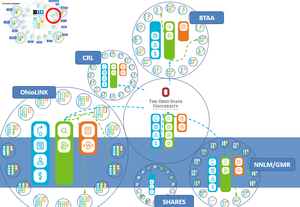The Washington Post is carrying a story on collection development at Fairfax County Public Library. Collection development? Well, the hook is more their ‘data driven’ policy on discards.
“We’re being very ruthless,” said Sam Clay, director of the 21-branch system since 1982. “A book is not forever. If you have 40 feet of shelf space taken up by books on tulips and you find that only one is checked out, that’s a cost.”
That is the new reality for the Fairfax system and the future for other libraries. As books on tape, DVDs, computers and other electronic equipment crowd into branches, there is less room for plain old books.
So librarians are making hard decisions and struggling with a new issue: whether the data-driven library of the future should cater to popular tastes or set a cultural standard, even as the demand for the classics wanes. [Hello, Grisham — So Long, Hemingway? – washingtonpost.com]
Diane Kresh from neighboring Arlington is also quoted:
Arlington County’s library director, Diane Kresh, said she’s “paying a lot of attention to what our customers want.” But if they aren’t checking out Rachel Carson’s “Silent Spring,” she’s not only keeping it, she’s promoting it through a new program that gives forgotten classics prominent display. “Part of my philosophy is that you collect for the ages,” Kresh said. “The library has a responsibility to provide a core collection for the cultural education of its community.”[Hello, Grisham — So Long, Hemingway? – washingtonpost.com]
As my colleague Brian Lavoie noted recently, many questions come back to economics, the analysis of how people make decisions. He cites some principles of economics and the first two are very relevent here: 1. People face trade-offs (in an environment of scarce resources expansion in one area requires retrenchment in another), and 2. The cost of something is what you give up to get it (opportunity costs described by Brian in this way “the cost of choosing to undertake one activity includes not just the cost of carrying it out, but also the benefits foregone by not choosing something else”).
This article nicely underlines just these issues. There is a tradeoff between retaining stock and providing materials which boost circulation. And if circulation is a key indicator of success, and support, then this is important. And, in an environment where space resources are scarce, what is the opportunity cost in terms of space utilization or meeting other demands if one does not move materials from the shelves?
This is another example of how the opportunity costs of existing widely distributed print collections are an issue. It also poses in an interesting way the question about what responsibility to the cultural record public libraries have, and how it should should be exercised in changing times.
One direction is towards more shared systems of discovery, delivery and inventory management where the costs of managing lower used collections may be shared and where a collective approach to stewarding materials can be taken. Of course, this raises issues of structure, organization and …. economics.
Incidentally, I spoke at a staff day in Arlington a few weeks ago. I had a very enjoyable half-day in the library talking with Diane and a very engaged staff. I learned a lot talking to folks, which is why, in general, I prefer speaking to smaller library groups than to the larger conferences.
Washington Post article via Peter Brantley, who takes up his new post as Executive Director of the DLF in February.
Related entries:Related entries:



